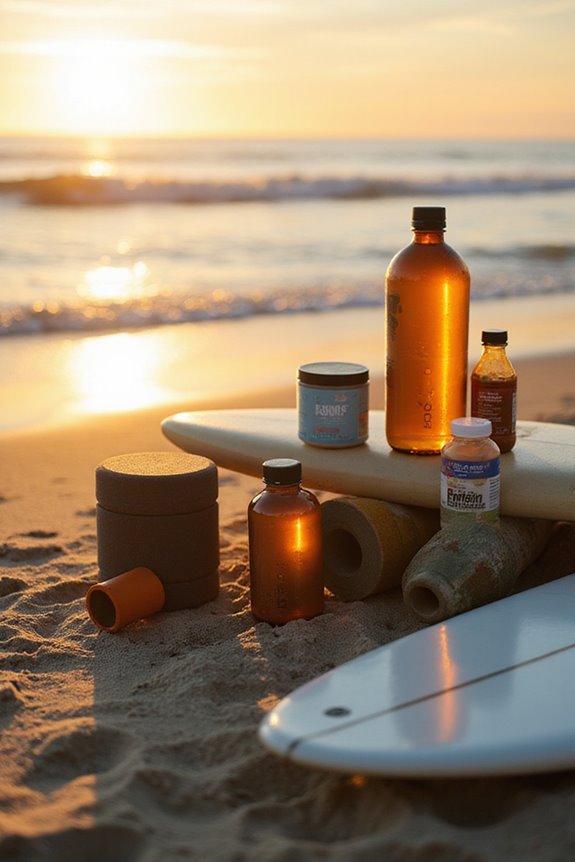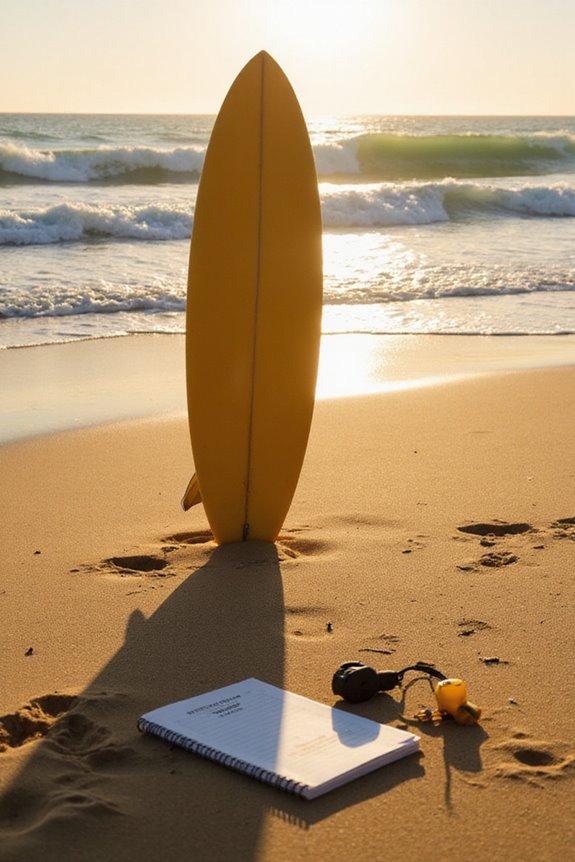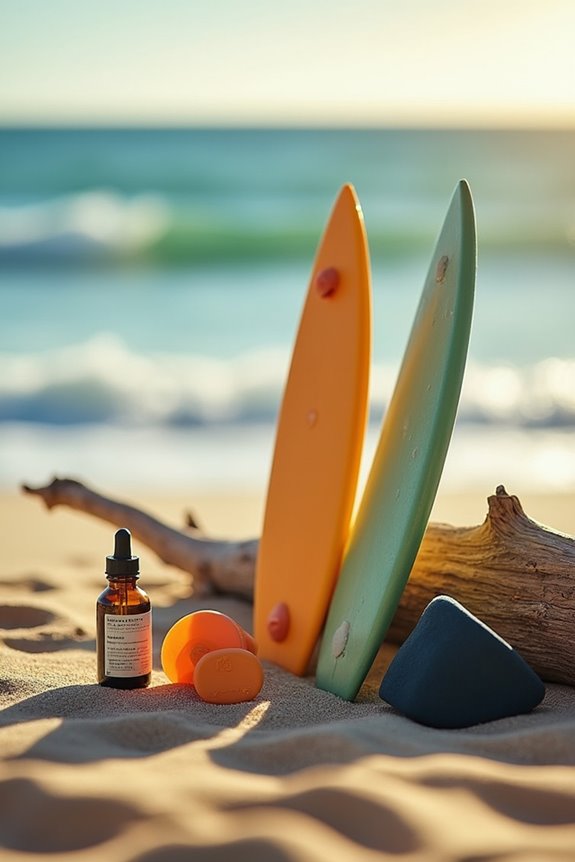To speed up our recovery after surfing, we should focus on key strategies. First, we need to prioritize hydration, consuming 5–10 ml/kg of fluids before our sessions and at least 16 oz for every pound lost post-surfing. Incorporating deep diaphragmatic breathing and hot/cold therapy can reduce muscle fatigue and improve circulation. We should also maintain a balanced diet rich in electrolytes. By implementing these methods, we can enhance our recovery process and overall performance. More insights await us ahead.
Key Takeaways
- Practice deep diaphragmatic breathing to restore oxygen levels and reduce muscle fatigue after surfing.
- Incorporate hot and cold therapy to minimize inflammation and enhance circulation for quicker recovery.
- Engage in active rest activities, such as light stretching or walking, to promote nutrient delivery to fatigued muscles.
- Maintain proper hydration and consume electrolyte-rich beverages to prevent cramps and aid recovery.
- Prioritize physical rehabilitation and balance training to strengthen muscles and prevent future injuries.
Understanding Fatigue and Muscle Recovery
When we surf, our bodies undergo significant physiological changes that lead to fatigue. Muscle fatigue arises quickly from the high energy demand of paddling, depleting oxygen and impairing muscle repair. This can cause soreness and tiredness, impacting our performance.
To enhance recovery, we can employ various techniques. Deep diaphragmatic breathing helps restore oxygen levels, while alternating hot and cold therapy reduces inflammation and improves circulation. Active rest, such as light swimming or walking, promotes nutrient delivery to fatigued muscles, preventing stiffness. Additionally, maintaining heart rate recovery through controlled breathing aids in minimizing systemic fatigue. By integrating these recovery techniques into our routine, we can better manage muscle fatigue and improve our overall surfing experience. Incorporating yoga poses into your recovery routine can further enhance flexibility and reduce soreness.
Importance of Physical Rehabilitation and Balance

Recovery from surfing-related fatigue is only part of maintaining our performance on the waves. Integrating physical rehabilitation techniques is essential for addressing specific injuries while enhancing our overall balance. Customized plans focus on strengthening key muscle groups, such as the rotator cuff and core, to support our surfing movements and reduce injury risk. Incorporating tools like balance boards can further enhance our training regimen, allowing for improved stability during workouts.
Balance training plays a crucial role in improving our coordination and stability. Exercises like planks and dynamic balance drills help us maintain control on the surfboard, especially during rapid pop-ups and turns. By prioritizing rehabilitation and balance training, we can enhance our surfing performance, prolong our careers, and boost our resilience against fatigue and injury.
Strategies for Injury Prevention and Management
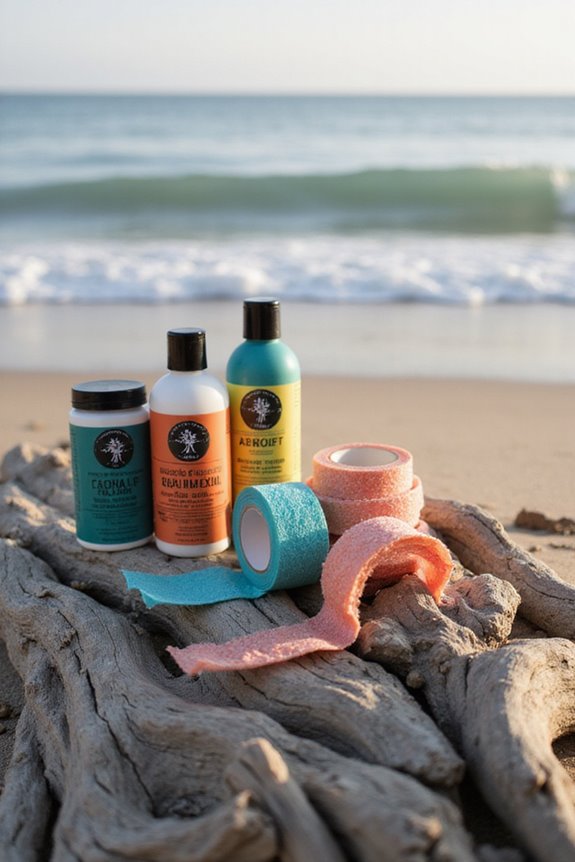
To minimize the risk of injuries while surfing, we must adopt a proactive approach that encompasses various strategies. First, we should select surf spots carefully, avoiding crowded areas to reduce collision risks. Practicing good lineup etiquette and staying within our skill levels are essential for injury prevention.
Using protective equipment like helmets, impact vests, and suitable wetsuits can greatly lower the severity of injuries. Regularly inspecting our gear guarantees it’s safe and functional. Incorporating specific training for paddling and balance can enhance our physical conditioning, while understanding common injury types helps us recognize symptoms early. Finally, learning proper falling techniques can reduce impact injuries. By following these strategies, we can enjoy safer surf sessions. Additionally, utilizing safety features such as inflatable boards with high-density fabrics can improve stability and reduce injury risk.
Psychological and Social Benefits of Surf Therapy
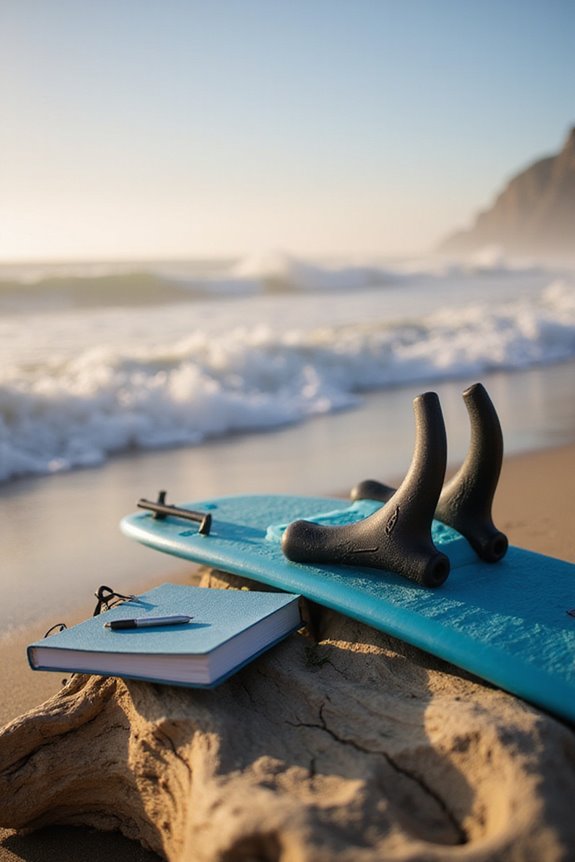
Surf therapy offers a unique blend of psychological and social benefits that can enhance our overall well-being. It has shown improvements in mental health outcomes, particularly reducing symptoms of depression, anxiety, and PTSD. Participants often feel a sense of community support, as the group setting normalizes mental health struggles and fosters social connections.
Through shared experiences, we develop skills like trust and communication, which strengthen our relationships. Learning to surf not only boosts our confidence but also promotes resilience and coping strategies. The supportive environment encourages personal growth, making us feel empowered in managing mental health challenges. By participating in surf therapy, we find both emotional safety and a sense of belonging within a community. Additionally, engaging in surfing can provide access to local surf schools that offer lessons, further enhancing the sense of community and support.
Enhancing Cardiovascular and Aerobic Conditioning

While we enjoy the thrill of riding waves, focusing on our cardiovascular and aerobic conditioning can greatly improve our surfing performance. Engaging in effective cardio techniques enhances our endurance, allowing us to surf longer and recover faster between waves.
To boost our aerobic fitness, we can incorporate activities like:
- Swimming: Mimics paddling movements, improving cardiovascular efficiency.
- Interval Sprints: Builds explosive power for quick bursts when catching waves.
- Long-Distance Running: Develops aerobic stamina for extended sessions.
These aerobic exercises not only enhance our overall performance but also support muscle recovery by improving blood circulation and oxygen delivery. By prioritizing cardiovascular conditioning, we can achieve longer surfing sessions and better overall health. Additionally, incorporating surf schools can provide structured training to further enhance our skills and fitness levels.
Nutrition and Hydration for Optimal Recovery
Nutrition and hydration play vital roles in our recovery after surfing, guaranteeing that we can perform at our best during our next session. Effective hydration strategies include consuming 5–10 ml/kg of fluids 2 to 4 hours before we hit the waves. After surfing, we should aim for at least 16 oz of fluid for every pound of weight lost.
Incorporating electrolyte-rich beverages, like coconut water or sports drinks, helps maintain electrolyte balance, replenishing salts lost through sweat. This is essential to prevent cramps and support muscle function. By sipping fluids regularly during and after our sessions, we can enhance absorption and facilitate optimal hydration, allowing us to recover faster and prepare for our next adventure. Additionally, being mindful of skin protection strategies can help prevent sunburn and skin damage, further promoting overall recovery.
Frequently Asked Questions
How Long Should I Rest After a Surfing Session?
After riding the waves, we should let our bodies breathe. A rest duration of 48 hours is ideal, but implementing recovery techniques like stretching and nutrition can make all the difference in our surf game.
What Are the Best Stretches for Post-Surf Recovery?
When we think about the best stretches for post-surf recovery, incorporating dynamic stretches before and static stretches afterward can help us effectively relieve muscle tension and improve flexibility, ensuring we’re ready for our next session.
When Should I See a Doctor for Surf-Related Injuries?
We’re not doctors, but if surf injuries leave us in pain or create visible deformities, seeking medical advice might just be our wisest choice. Ignoring symptoms could lead to waves of trouble we don’t want.
Can Yoga Help Improve My Surfing Recovery?
Absolutely, we can enhance our recovery with yoga. Incorporating yoga poses and focusing on breath control helps us relax, improve circulation, and strengthen our bodies, ultimately leading to better recovery and performance in the water.
What Mental Exercises Aid in Recovery After Surfing?
Isn’t it fascinating how our minds can shape our recovery? By practicing visualization techniques and mindfulness meditation, we can enhance our mental clarity and emotional resilience, making our post-surf experience even more enriching and fulfilling together.

